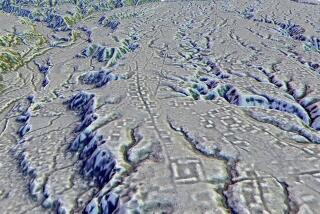Rice cultivated in China 7,700 years ago
- Share via
Stone Age people began cultivating rice in what is now China more than 7,700 years ago by burning trees in coastal marshes and building dams to hold back seawater, converting the marshes to rice paddies that would support growth of the high-yield cereal grain, researchers reported today.
New analysis of sediments from the site of Kuahuqiao at the mouth of the Yangtze River near present-day Hangzhou provides the earliest evidence in China of such large-scale environmental manipulation, experts said.
“It shows people were changing the environment, actively manipulating the system, and well on their way to having an agricultural way of life,” said anthropologist Gary Crawford of the University of Toronto at Mississauga, who was not involved in the research.
Using data from the site, it is possible to extrapolate a timeline back to the first attempts at domesticating rice, which would have occurred about 10,000 years ago, said archeologist Li Liu of La Trobe University in Victoria, Australia, who was also not involved. That is contemporary with the development of agriculture in the Middle East.
The finding also sheds new light on an ongoing controversy in archeology: How long did it take for crops to become fully domesticated?
The evidence from China, and new finds elsewhere, indicates that the process took much longer than previously thought, said archeobotanist Dolores Piperno of the Smithsonian Tropical Research Institute in Panama.
Nonetheless, she said, there is now “little doubt that by 7,700 years ago, these people were dedicated rice farmers. . . . I think people were getting all the benefits of agriculture before plants were fully domesticated.”
When agriculture developed is a key question in archeology because the production of abundant food, thereby freeing time for other pursuits, is one of the chief requirements for development of a civilization.
Kuahuqiao was discovered in the early 1970s after it was exposed by the construction of a brick factory. The site is buried under 9 to 12 feet of sediment, which led to remarkable preservation of organic materials.
Chinese archeologists have found remnants of wooden houses built on stilts over the water, fine pottery that initially made researchers think the site was more recent, bamboo and wooden tools and even a dugout canoe, complete with paddles.
In the newest study, Yongqiang Zong of Durham University in England and colleagues from East China Normal and Fudan universities in Shanghai studied the sediment itself, looking for pollen, algal and fungal spores and charcoal from fires. Their report in the journal Nature provides a precise timeline for occupation of the site.
The site was originally a marshy freshwater environment dominated by birch and willow trees and then alders. “Then, about 7,700 years ago, a group of humans moved in,” Zong said in a telephone interview. “There was a sudden increase in the use of fire and the disappearance of the older type of vegetation.”
The trees were replaced by rice and cattail, which was also used as a food source. “The human activity there was quite intense,” Zong said. Particles of charcoal in the sediment indicate that inhabitants burned brush regularly to keep the site clear, and pig bones and other evidence indicate that they were using manure to fertilize the paddies, he said.
Researchers know that ocean levels were gradually rising during this period from the melting of ice after the end of a glacial period. If there had been no humans at Kuahuqiao, the water in the marsh would have become more brackish over the years, Zong said.
The pollen and fungal evidence, however, doesn’t indicate increasing saltiness. That suggests that the people who lived there erected low earthen dikes, called bunds, to keep the seawater out so that it did not impair rice growth, he said.
By about 7,550 years ago, however, the ocean had risen so much that the primitive dikes could no longer hold it back. The site was inundated, and its residents were forced to move to safer areas up the coast and perhaps inland as well.
“They continued cultivating rice, leading to the completion of domestication more than 1,000 years later,” Zong said.
“The dates are in a beautiful sequence, and really tight,” said Toronto’s Crawford.
--





